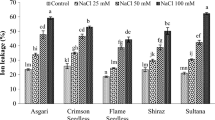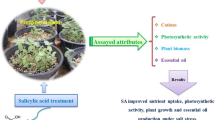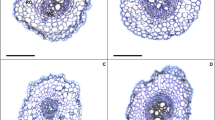Abstract
This work focused on the effect triterpene derivative 24-methylen-elemo-lanosta-8,24-dien-3-one (F3) on the induction of salt stress tolerance of the Moroccan grapevine cv. “Doukkali”. Hardwood cuttings of the grapevine from a homogeneous plant material collected in the field were grown in hydroponic medium under different salt concentrations and treated with 50 or 100 µg ml−1 of F3. Salt stress affected several physiological and biochemical parameters including relative water content, chlorophyll a and b content, peroxidase, and polyphenol oxidase activities, which decreased along with time. Meanwhile, proline, proteins, soluble sugars, H2O2, and carotenoid content, as well as phenolic compound content increased, suggesting an evidence of tolerance of this local variety to salinity. An exogenous supply of the triterpenic product increased all these parameters under normal conditions. In addition, F3 at low dose was found to be successful in lowering Na+ content and alleviating the inhibitory effects of salt stress on relative water content as well as on chlorophyll a and b.






Similar content being viewed by others
References
Abbas S, Latif HH, Elsherbiny EA (2013) Effect of 24-epibrassinolide on the physiological and genetic changes on two varieties of pepper under salt stress conditions. Pak J Bot 45:1273–1284
Acosta-Motos JR, Ortuño MF, Bernal-Vicente A, Diaz-Vivancos P, Sanchez-Blanco MJ, Hernandez JA (2017) Plant responses to salt stress: adaptive mechanisms. Agronomy 7:18. https://doi.org/10.3390/agronomy7010018
Agami RA (2013) Alleviating the adverse effects of NaCl stress in maize seedlings by pretreating seeds with salicylic acid and 24-epibrassinolide. South Afr J Bot 88:171–177
Ainsworth EA, Gillespie KM (2007) Estimation of total phenolic content and other oxidation substrates in plant tissues using Folin–Ciocalteu reagent. Nat Protoc 2:875–877
Al Hassan M, Morosan M, Lpoez-Gresa MdP, Vicente O, Boscaiu M (2016) Salinity-induced variation in biochemical markers provides insight into the mechanisms of salt tolerance in common (Phaseolus vulgaris) and runner (P. coccineus) beans. Int J Mol Sci 17:1582. https://doi.org/10.3390/ijms17091582
Ali B, Hayat S, Fariduddin Q, Ahmad A (2008) 24-Epibrassinolide protects against the stress generated by salinity and nickel in Brassica juncea. Chemosphere 72:1387–1392
Avalbaev AM, Yuldashev RA, Fatkhutdinova RA, Urusov FA, Safutdinova YV, Shakirova FM (2010) The influence of 24-epibrassinolide on the hormonal status of wheat plants under sodium chloride. Appl Biochem Microbiol 46:99–102
Bajguz A (2000) Effect of brassinosteroids on nucleic acid and protein content in cultured cell of Chlorella vulgaris. Plant Physiol Biochem 38:209–215
Bajguz A, Tretyn A (2003) The chemical characteristic and distribution of brassinosteroids in plants. Phytochemistry 62:1027–1046
Basel S (2012) Salt stress alters physiological indicators in cotton (Gossypium hirsutum L.). Soil Environ 31:113–118
Bates LS, Waldren RD, Teare ID (1973) Rapid determination of free proline for water stress studies. Plant Soil 39:205–207
Ben Abdallah S, Aung B, Aymot L, Lachaal M, Karray-Bouraoui N, Hannoufi A (2016) Salt stress (NaCl) affects plant growth and branch pathways of carotenoids and flavonoids biosynthesis in Solanum nigrum. Acta Physiol Plant 38:72–84
Bradford M (1976) A rapid and sensitive method for the quantitation of protein utilizing the principe of protein—dye briding. Anal Biochem 72:248–254
Coleman WK (2008) Evaluation of wild solanum species for drought resistance: 1. Solanum gandarillasii Cardenas. Environ Exp Bot 62:221–230
Cui D, Wu D, Liu J, Li D, Xu C, Li S, Li P, Zhang H, Liu X, Jiang C, Wang L, Chen T, Chen H, Zhao L (2015) Proteomic analysis of seedling roots of two maize inbred lines that differ significantly in the salt stress response. PLoS One 10:e0116697. https://doi.org/10.1371/journal.pone.0116697
Darne G, Madero-Tamargo J (1979) Description of method for extracting total soluble lipids, total soluble glucides and total soluble phenols of vine organs. Vitis 18:221–228
Dash M, Panda K (2001) Salt stress induced changes in growth and enzyme activities. Biol Plant 44:587–589
De Costa F, Yendo AC, Fleck JD, Gosmann G, Fett-Neto AG (2013) Accumulation of bioactive triterpene saponin fraction of Quillaja brasiliensis leaves is associated with abiotic and biotic stresses. Plant Physiol Biochem 66:56–62
De Pascal S, Maggio A, Fogliano V, Ambrosino P, Ritieni A (2001) Irrigation with saline water improves carotenoids content and antioxidant activity of tomato. J Hortic Sci Biotechnol 76:447–453
Djanaguiraman M, Ramadass R (2004) Effect of salinity on chlorophyll content of rice genotypes. Agric Sci Digest 24:178–181
Downton WJS, Loveys BR, Grant WJR (1990) Salinity effects on the stomatal behavior of grapevine. New Phytol 116:499–503
Du Bois M, Gilles KA, Hamilton JK, Rebers PA, Smith F (1956) Colorimetric method for determination of sugars and related substances. Anal Chem 28:350–356
Fozouni M, Abbaspour N, Doulati Baneh H (2012) Short term response of grapevine grown hydroponically to salinity: mineral composition and growth parameters. Vitis 51:95–101
Garcia M, Charbaji T (1993) Effect of sodium chloride salinity on cation equilibria in grapevine. J Plant Nutr 16:2225–2237
Hansen TH, Laursen KH, Persson DP, Pedas P, Husted S, Schjoerring JK (2009) Micro-scaled high-throughput digestion of plant tissue samples for multi-elemental analysis. Plant Methods 5:12. https://doi.org/10.1186/1746-4811-5-12
Haubrick LL, Assman SM (2006) Brassinosteroids and plant function: some clues, more puzzles. Plant Cell Environ 29:446–457
Huang Z, Zhao L, Chen D, Liang M, Liu Z, Shao H, Long X (2013) Salt stress encourages proline accumulation by regulating proline biosynthesis and degradation in Jerusalem Artichoke plantlets. PLoS One 8:e62085. https://doi.org/10.1371/journal.pone.0062085
Inskeep WP, Bloom PR (1985) Extinction coefficients of chlorophyll a and b in N, N-dimethyl formamide and 80% acetone. Plant Physiol 77:483–485
Karlidag H, Yilidirim E, Turam M (2011) Role of 24-epibrassinolide in mitigating the adverse effects of salt stress on stomatal conductance, membrane permeability and leaf water content, ionic composition in salt stressed strawberry (Fragaria × ananassa). Sci Hortic 130:133–140
Kim HJ, Chen F, Wang X, Choi JH (2006) Effect of methyl jasmonate on phenolics, isothiocyanate, and metabolic enzymes in radish sprout (Raphanus sativus L.). J Agric Food Chem 54:7263–7269
Lichtenthaler HK (1987) Chlorophylls and carotenoids: pigments of photosynthetic biomembranes. Method Enzymol 148:350–382
Masia A, Ventura M, Gemma H, Sansavini S (1998) Effect of some plant growth regulator treatments on apple fruit ripening. Plant Growth Regul 25:127–134
Misra N, Gupta AK (2005) Effect of salt stress on proline metabolism in two high yielding genotypes of green gram. Plant Sci 169:331–339
Moerschbacher B, Heck B, Kogel KH, Obs O, Reisener H (1986) An elicitor of the hypersensitive lignification response in wheat leaves isolated from the rust fungus Puccinia graminis f. sp. tritici. II. Induction of enzymes correlated with the biosynthesis of lignin. Z Naturforsch 41:839–844
Mohammdkhani N, Heidari R, Abbaspour N (2013) Effects of salinity on antioxidant system in four grape (Vitis vinifera L.). Vitis 52:105–110
Mordue AJ, Blackwell A (1993) Azadirachtin: an update. J Insect Physiol 39:303–324
Munns R (2002) Comparative physiology of salt and water stress. Plant Cell Environ 25:239–250
Munns R, James RA, Lauchli A (2006) Approaches to increasing the salt tolerance of wheat and other cereals. J Exp Bot 57:1025–1043
Patakas A, Noitsakis B (1999) Mechanisms involved in diurnal changes of osmotic potential in grapevines under drought conditions. J Plant Physiol 154:767–774
Peng Z, He P, Sun J, Pan Z, Gong W, Lu Y, Du X (2016) Na+ compartmentalization related to salinity stress seedlings. Sci Rep 6:34848. https://doi.org/10.1038/srep34548
Pereira PS, Ticli FK, França SC, de Souza Breves CM, Lourenco MV (2007) Enhanced triterpene production in Tabernaemontana catharinensis cell suspension cultures in response to biotic elicitors. Quim Nova 30:1349–1852
Plengmuankhae W, Tantitadapitak C (2015) Low temperature and water dehydration increase the levels of asiaticoside and madecassoside in Centella asiatica (L.) urban. South Afr J Bot 97:196–203
Rady MM (2011) Effect of 24-epibrassinolide on growth, yield, antioxidant system and cadmium content of bean (Phaseolus vulgaris L.) plants under salinity and cadmium stress. Sci Hortic 129:232–237
Sasse JM (2003) Physiological actions of brassinosteroids: an update. Plant Growth Regul 22:276–288
Saxena I, Srikanth S, Chen Z (2016) Cross talk between H2O2 and interacting signal molecules under plant stress response. Front Plant Sci 7:570. https://doi.org/10.3389/fpls.2016.00570
Shahbaz M, Ashraf M (2007) Influence of exogenous application of brassinosteroids on growth and mineral nutrients of wheat (Triticum aestivum L.) under saline conditions. Pak J Bot 39:513–522
Shahid MA, Pervez MA, Balal RM, Mattson NS, Rashid A, Ahmad R et al (2011) Brassinosteroid (24-epibrassinolide) enhances growth and alleviates the deleterious effects induced by salt stress in pea (Pisum sativum L.). Aust J Crop Sci 5:500–510
Shang Q, Song S, Zhang Z, Guo S (2006) Exogenous brassinosteroid induced salt resistance of cucumber (Cucumis sativus L.) seedlings. Sci Agric Sin 39:1872–1877
Sharma I, Ching E, Saini S, Bhardwaj R, Pati PK (2013) Exogenous application of brassinosteroid offers tolerance to salinity by altering stress responses in rice variety pusa basmati-1. Plant Physiol Biochem 69:17–26
Sharma I, Bhardwaj R, Pati PK (2015) Exogenous application of 28-homobrassinolide modulates the dynamics of salt and pesticides induced stress responses in an elite rice variety pusa basmati-1. J Plant Growth Regul 34:509–518
Shrivastava P, Kumar R (2015) Soil salinity: a serious environmental issue and plant growth promoting bacteria as one of the tools for its alleviation. Saudi J Biol Sci 22:123–131
Sirhindi G, Kumar S, Bharadwaj R, Kumar R (2009) Effects of 24-epibrassinolide and 28-homobrassinolide on the growth and antioxidant enzyme activities in the seedlings of Brassica juncea L. Physiol Mol Plant Pathol 15:335–341
Smaili A, Mazoir N, Rifai LA, Koussa T, Makroum K, Benharref A, Faize L, Alburquerque N, Burgos L, Belfaiza M, Faize M (2017a) Antimicrobial activity of two semisynthetic triterpene derivatives from Euphorbia officinarum latex against fungal and bacterial phytopathogens. Nat Prod Commun 12:331–336
Smaili A, Mazoir N, Rifai LA, Koussa T, Makroum K, Kabil EM, Benharref A, Faize M (2017b) Triterpene derivatives from Euphorbia enhance resistance against Verticillium wilt of tomato. Phytochemistry 135:169–180
Stobart A, Griffiths WT, Ameen-Bukhari I, Sherwood RP (1985) The effect of Cd2+ on the biosynthesis of chlorophyll in leaves of barley. Physiol Plant 6:293–298
Taffouo VD, Wamba OF, Yombi E, Nono GV, Akoa A (2010) Growth, yield, water status and ionic distribution response of three bambara groundnut (Vigna subterranean (L.) verdc.) landraces grown under saline conditions. Int J Bot 6:53–58
Taibi K, Taibi T, Ait Abderrahim L, Ennajah A, Belkhodja M, Mulet JM (2016) Effect of salt stress on growth, chlorophyll content, lipid peroxidation and antioxidant defence systems in Phaseolus vulgaris L. South Afr J Bot 105:306–312
Taranto F, Pasqualone A, Mangini G, Tripodi P, Miazzi MM, Pavan S, Montemurro C (2017) Polyphenol oxidases in crops: biochemical, physiological and genetic aspects. Int J Mol Sci 18:377. https://doi.org/10.3390/ijms18020377
Thimmappa R, Geisler K, Louveau T, O’Maille P, Osbourn A (2014) Triterpene biosynthesis in plants. Annu Rev Plant Biol 65:225–257
Vardhini BV, Anjum NA (2015) Brassinosteroids make plant life easier under abiotic stresses mainly by modulating major components of antioxidant defense system. Front Environ Sci 2:1–15. https://doi.org/10.3389/fenvs2014.00067
Vardhini BV, Sujatha E, Rao SSR (2012) Influence of brassinosteroids on metabolites of Raphanus sativus L. J Phytol 4:45–47
Wahid A, Ghazanfar A (2006) Possible involvement of some secondary metabolites in salt tolerance of sugarcane. J Plant Physiol 163:723–730
Walker PR, Blackmore DH, Clingeleffer PR (2010) Impact of rootstock on yield and ion concentrations in petioles, juice and wine of Shiraz and Chardonnay in different viticultural environments with different irrigation water salinity. Aust J Grape Wine Res 16:243–257
Wang CM, Zhang JL, Liu S, Li Z, Wu GQ, Cai JY, Flowers TJ, Wang SM (2009) Puccinellia tenuiflora maintains a low Na+ level under salinity by limiting unidirectional Na+ influx resulting in a high selectivity for K+ over Na+. Plant Cell Environ 32:486–496
Wang Z, Zhang P, Meng J, Xi Z (2015) Effect of exogenous 24-epibrassinolide on chlorophyll fluorescence, leaf surface and cellular ultrastructure of grape seedlings (Vitis vinifera L.) under water stress. Acta Physiol Plant 37:1729–1740
Wu JY, Wong K, Ho KP, Zhou LG (2005) Enhancement of saponin production in Panax ginseng cell culture by osmotic stress and nutrient feeding. Enzyme Microb Technol 36:133–138
Yu IQ, Huang LF, Hu WH, Zhou YH, Mao WH, Ye SF, Nogues S (2004) A role of brassinosteroids in the regulation of photosynthesis in Cucumis sativas. J Exp Bot 55:1135–1143
Zine H, Rifai LA, Koussa T, Bentiss F, Guesmi S, Laachir A, Makroum K, Belfaiza M, Faize M (2017) Themononuclear nickel(II) complex bis(azido-κN)bis[2,5-bis(pyridin-2-yl)-1, 3,4-thiadiazole-κ2N2, N3]nickel(II) protects tomato from Verticillium dahliae by inhibiting fungal growth and activating plant defences. Pest Manag Sci 73:188–197
Acknowledgements
We thank Dr. N. Alburquerque from CEBAS-CSIC (Murcia, Spain) for carrying out the mineral analyses of the samples.
Author information
Authors and Affiliations
Corresponding author
Additional information
Communicated by L. Bavaresco.
Rights and permissions
About this article
Cite this article
Rifai, L.A., Mazoir, N., Koussa, T. et al. Foliar application of the triterpene derivative 24-methylen-elemo-lanosta-8,24-dien-3-one alleviates salt toxicity in grapevine. Acta Physiol Plant 40, 57 (2018). https://doi.org/10.1007/s11738-018-2636-5
Received:
Revised:
Accepted:
Published:
DOI: https://doi.org/10.1007/s11738-018-2636-5




